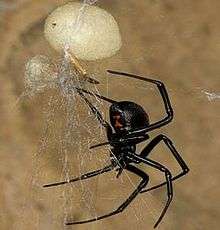Latrodectus hesperus
| Latrodectus hesperus | |
|---|---|
 | |
| Latrodectus hesperus female | |
| Scientific classification | |
| Kingdom: | Animalia |
| Phylum: | Arthropoda |
| Subphylum: | Chelicerata |
| Class: | Arachnida |
| Order: | Araneae |
| Infraorder: | Araneomorphae |
| Family: | Theridiidae |
| Genus: | Latrodectus |
| Species: | L. hesperus |
| Binomial name | |
| Latrodectus hesperus Chamberlin & Ivie, 1935[1] | |
Latrodectus hesperus, the western black widow spider or western widow, is a venomous spider species found in western regions of North America. The female's body is 14–16 mm (1/2 in) in length and is black, often with an hourglass-shaped red mark on the lower abdomen. This "hourglass" mark can be yellow, and on rare occasions, white. The male of the species is around half this length and generally a tan color with lighter striping on the abdomen. The population was previously described as a subspecies of Latrodectus mactans and it is closely related to the northern species Latrodectus variolus. The species, as with others of the genus, build irregular or "messy" webs: Unlike the spiral webs or the tunnel-shaped webs of other spiders, the strands of a Latrodectus web have no apparent organization. Female black widows have potent venom composed of neurotoxins. Fatalities usually only happen with children and the elderly, however medical treatment may be required for others as well. However, the male black widow is harmless to humans. The female's consumption of the male after courtship, a cannibalistic and suicidal behavior observed in Latrodectus hasseltii (Australia's redback),[2] is rare in this species. Male western widows may breed several times during their relatively short lifespans.[3] Males are known to show preference for mating with well-fed females over starved ones, taking cues from the females' webs.[4]
Range
Latrodectus hesperus can be found in western regions of North America. In Canada it can be found from British Columbia, to Manitoba They are most commonly found near the Canada-US border, as well less commonly throughout prairies regions of the Canadian Prairies in Western Canada.[5][6]
Sexual behavior
Female stimulates by contact with male webs Male and female Latrodectus hesperus produce sexually specific scents which are combined with their silk; each sex responds by initiating mating when it comes in contact with a web of the opposite sex.[7]
Feeding
Latrodectus hesperus frequently hangs upside down near center of the web and waits for any insects to enter the web to attack. It bites its victim then wraps it in silk.
Ecology
Latrodectus hesperus has a few parasites or predators known to affect them; parasites include wasps in the family Scelionidae and flies in the family Acroceridae, and flies in the genus Pseudogaurax, while the most common predator is the wasp Chalybion californicum.
Interactions with humans
Latrodectus hesperus often live in human dwellings, usually in cluttered dark areas. It has poor eyesight, and detects danger by silk vibration. Only female spiders have venom glands large enough for a bite to be harmful and require medical treatment.
Silk
The ultimate strength and other physical properties of L. hesperus silk were found to be similar to the properties of silk from orb-weaving spiders that had been tested in other studies. The ultimate strength for the three kinds of silk measured in the study was about 1000 MPa. The ultimate strength reported in a previous study for Nephila edulis was 1290±160 MPa[8] (The ultimate strength of mild steel is about 800 MPa.)
Gallery
 Female with egg sac
Female with egg sac Immature female
Immature female Female with typical red hourglass on abdomen
Female with typical red hourglass on abdomen- Male, dorsal view (light coloration)
- Male, ventral view (light coloration)
- Male, dorsal view (dark coloration)
- Male, ventral view (dark coloration)
- Female, front view, with moth and funnel web spider prey
- Female, side view
- Female, ventral view
 Typical female from California
Typical female from California
References
- ↑ Chamberlin, R. V. & W. Ivie. 1935. The black widow spider and its varieties in the United States. Bull. Univ. Utah 25(8): 1-29. [15, f. 1, 4, 6-14, 21, 23-33]
- ↑ Andrade, Maydianne C. B. (5 January 1996). "Sexual Selection for Male Sacrifice in the Australian Redback Spider". Science. 271 (5245): 70–2. Bibcode:1996Sci...271...70A. doi:10.1126/science.271.5245.70. Retrieved 2007-01-15.
- ↑ "Black Widow Spiders". Hastings Reserve.
- ↑ Johnson, J. Chadwick; Trubl, Patricia Trubl; Blackmore, Valerie; Miles, Lindsay (2011). "Male black widows court well-fed females more than starved females: silken cues indicate sexual cannibalism risk". Animal Behaviour. 82 (2): 383–390. doi:10.1016/j.anbehav.2011.05.018.
- ↑ "Western Black Widow (Latrodectus hesperus)". The Royal Alberta Museum. The Royal Alberta Museum. Retrieved 23 May 2016.
- ↑ "NCC Black Widow". National Convergency Canada. Government of Canada.
- ↑ Ross, Kenneth; et al. "Aspects of the Courtship Behavior of the Black Widow Spider, Latrodectus hesperus (Araneae: Theridiidae), with Evidence for the Existence of a Contact Sex Pheromone (abstract)". American Arachnological Society. Retrieved 2015-01-22.
- ↑ Blackledge, Todd; et al. "Quasistatic and continuous dynamic characterization of the mechanical properties of silk from the cobweb of the black widow spider Latrodectus hesperus, table 1". The Company of Biologists. Retrieved 2009-01-23.
- Minus, A. 2001. "Latrodectus hesperus" (On-line), Animal Diversity Web. Accessed March 8, 2009
- Platnick, N. I. 2008. Theridiidae The World Spider Catalog, version 9.0. American Museum of Natural History.
External links
 Data related to Latrodectus hesperus at Wikispecies
Data related to Latrodectus hesperus at Wikispecies Media related to Latrodectus hesperus at Wikimedia Commons
Media related to Latrodectus hesperus at Wikimedia Commons- Western black widow